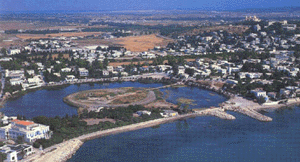Carthage
 |
| Actual Carthage |
Founded by the Phoenicians in 814 BC, the earliest settlements of Punic Carthage can still be seen on Byrsa Hill just below the renowned Carthage National Museum. Although destroyed by the Romans in 146 BC and later overbuilt by them, recent excavation have revealed the foundation of five-story Punic houses, each with its own cistern and drainage system.
The most remarkable early remains are the two basins of the Punic Ports, evidence of the Carthaginians' mastery of the sea, which fascinated and frustrated the Romans. Behind the rectangular commercial port, the circular naval harbor hid 202 slender military vessels. Another important site of pre-Roman Carthage is the Tophet, a burial ground and sanctuary to the punic deities Tanit and Baal.
Roman Carthage boasts the spectacular seaside remains of the Antonine Baths, the largest in the world of the second century AD. Nearby is the Theater, site of Carthage Festival every summer, the Amphitheater, a series of hilltop Roman Villas and the extensive Malaga Cisterns, which stored fresh water for this ancient city of nearly one million inhabitants. Once the home of Saint Augustine, Carthage has important Christian remains in its large Archeological Park and in the Paleo-Christian Museum. Among the many churches are Damous El Karita and the Basilica of Saint Cyprian.
For those interested in modern history, the extremely well-cared for U.S. War Cemetary has 2,841 simple graves, a memorial to the 3,724 missing soldiers and detailed maps illustrating the 1942-43 North African Campaign. |

